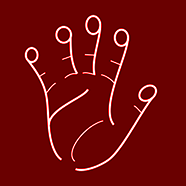
 H-Unique Project
H-Unique Project

This page shows the results of our approach to finger knuckle recognition [1] evaluated on two large landmark datasets using the base, major and minor knuckles that cover the metacarpophalangeal, proximal interphalangeal and distal interphalangeal joints respectively. By evaluating in this way, we can see how identifiable the individual knuckles are. By considering more than one knuckle for identification in a holistic approach, we can increase the chances of identification. You can see the results for different knuckles and knuckle combinations on each of the datasets by selecting options from the checkboxes below. We are currently showing performance on knuckles and as we progress with the project, we will expand this to include other anatomical features of the hand, including vein patterns, pigmentation and palmar creases.
Select data source and desired knuckle/finger combinations to load approproate CMC and ROC curves:
|
|
|
|||||||||
The curves demonstrate the performance of our approach on the selected knuckles. The Receiver Operating Characteristic (ROC) curve shows the robustness of the approach as a binary decision system for one-to-one matching as we adjust the decision threshold. The Cumulative Match Curve (CMC) is a measure of one-to-n matching performance. It helps to describe the ranking ability of a system.
11k: The 11k Hands dataset is a collection of 11,076 hand images of 190 subjects, aged between 18 and 75 years. Each subject was asked to open and close their fingers and each hand was photographed from both dorsal (top) and palmar (bottom) sides. Since we do not expect that knuckle creases are the same on both hands, we split this dataset into 11k_left and 11k_right, containing the left and right hands respectively. You can read more about this dataset in reference [2].
HD: The Hong Kong Polytechnic University Contactless Hand Dorsal Images Database is contributed from the male and female volunteers, largely acquired on the IIT Delhi Campus, The Hong Kong Polytechnic University campus and in villages in India during 2006-2015, mostly by using a mobile and hand held camera. This database has 2505 hand dorsal images from the right hand of 501 different subjects. This database also provides two session hand dorsal images, with many samples acquired after very long interval (4 to 8 years). You can read more about this dataset in reference [3].
[1] Vyas R, Rahmani H, Boswell-Challand R, Angelov P, Black S, Williams B. Robust End-to-End Hand Identification via Holistic Multi-Unit Knuckle Recognition. Accepted for the International Joint Conference on Biometrics (IJCB). 2021.
[2] Afifi M. 11K Hands: Gender recognition and biometric identification using a large dataset of hand images. Multimedia Tools and Applications. 2019 Aug;78(15):20835-54.
[3] Kumar A, Xu Z. Personal identification using minor knuckle patterns from palm dorsal surface. IEEE Transactions on Information Forensics and Security. 2016 May 30;11(10):2338-48.